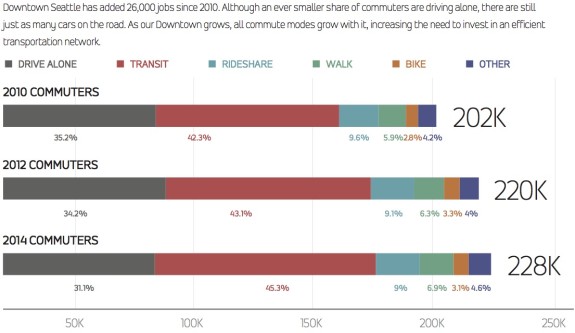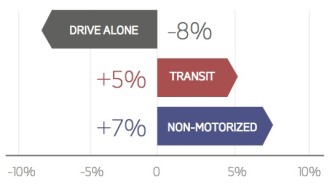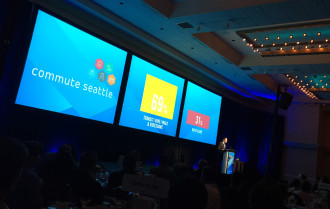
 The most recent Downtown Seattle Association/Commute Seattle survey (PDF) of downtown commute habits shows that 69 percent of workers do not drive alone to their jobs.
The most recent Downtown Seattle Association/Commute Seattle survey (PDF) of downtown commute habits shows that 69 percent of workers do not drive alone to their jobs.
Transit is by far the preferred way to get to downtown jobs, though walking, biking and telecommuting are also growing. Though the number of jobs downtown has been rising fast, the number of people driving alone to work has remained flat. People are getting to those new jobs using other means of transportation.
“As transit service continues to improve with Proposition 1 adding Metro service within Seattle, new Link light rail extensions on the way, and improved bicycle infrastructure, we expect these positive trends to continue,” Commute Seattle said in a press release.
There is one easy way to continue this trend: Connect neighborhood bike routes to and through downtown. Since 2010, bike commute rates are also fairly stagnant even as the number of people biking in other parts of the city increase dramatically. The Fremont Bridge bike counter has been measuring consistent increases in bike trips averaging 8.5 percent year-over-year. Yet these new bike trips are not making it all the way downtown, according to the survey. UPDATE: I learned that the mode split survey was taken in the final week of October 2014, which was exceptionally rainy. So weather likely played a role in the small apparent decrease in bicycle mode split.

And it really should not be a huge surprise. Biking downtown is a very uncomfortable experience, and the city made very few investments to make it any easier between 2010 and 2014.
But that could be changing. The 2nd Ave protected bike lane opened in September, the first significant change in bike infrastructure downtown in many years. But the downtown core is still lacking comfortable connections to basically every neighborhood. There simply are only so many people who are eager to bike in a busy, congested traffic lane shared with people driving. In fact, it’s kind of amazing so many people do this today.
Planned bike lane connections on Pike and 7th Ave will help connect to existing bike routes in big sections of north Seattle and Capitol Hill, for example. Improvements to Dearborn planned this year will address one notoriously uncomfortable section of bike route heading into south Seattle. But there’s still a whole lot more work to do.
With walking to work growing quickly, the city also needs to invest in improving safety and comfort for people on foot. Downtown is by far the most dangerous place in the city to walk. As we reported previously, the city’s Vision Zero plan includes a focus on reducing speed limits to 25 mph and limiting right turns on red in areas with high numbers of people walking.
Retiming traffic signals to give people more time to cross on foot and slow everyone to a safer and more consistent pace could also help improve safety. And if traffic signals encourage a safer pace, biking on downtown streets that do not yet have protected bike lanes could feel a bit more comfortable.
More details on the downtown commute survey, from Commute Seattle:
The proportion of Downtown Seattle commuters driving alone to work has fallen to a new low. According to a new Commute Seattle survey conducted by EMC Research[1], just 31 percent of Downtown’s estimated 228,000 daily commuters[2]drive alone to work, continuing a strong downward trend from 35 percent in 2010 and 34 percent in 2012.
Public transit[3] continues to be the top choice for Downtown commuters (45%), followed by driving alone (31%)[4], ridesharing[5] (9%), walking (7%), teleworking (4%) and bicycling (3%).
These encouraging results show that Commute Seattle is approaching its goal of decreasing Downtown’s drive-alone rate to 30 percent by 2016. Commute Seattle has focused its efforts for over ten years on Downtown businesses and property owners, helping them develop commute programs and incentives for their employees. As transit service continues to improve with Proposition 1 adding Metro service within Seattle, new Link light rail extensions on the way, and improved bicycle infrastructure, we expect these positive trends to continue.
Medium sized businesses (20-99 employees) led the way, reducing their drive-alone rate from 37 percent to 30 percent, nearly matching the 27 percent drive-alone rate among Downtown’s largest companies (100+ employees). “These results validate our strategic focus on Downtown small businesses,” said Commute Seattle Executive Director Jessica Szelag. “They reaffirm our commitment to ensure that the benefits of transit are shared by all commuters regardless of the size of their employer.”
Though the rate of driving alone declined, rapid job growth means that total traffic volumes are roughly equivalent to 2012, indicating a road network approaching full capacity. However, the overwhelming majority of new job growth is being accommodated by transit, walking, and bicycling.
“Downtown will only continue to grow and thrive if people can get here reliably, and Downtown businesses understand the need for faster, more reliable transit,” says Downtown Seattle Association President & CEO Jon Scholes. “We will continue to work to ensure that Downtown remains the region’s best place to live, work, shop, and play.”
“Seattle has great talent and the business climate to generate new jobs, but we must not let gridlock stifle that growth,” said Seattle Mayor Ed Murray. “We’re making the right investments and we must continue to provide the transportation choices that keep these trends moving in the right direction.”
“More commuters than ever are taking advantage of the reliable transit service we provide to Downtown Seattle,” said King County Executive Dow Constantine, who is also Chair of the Sound Transit Board of Directors. “Our region’s prosperity relies on people’s ability to get to and from work each day, so it’s critical that we build the transportation systems needed to keep up with our growing population.”








Comments
14 responses to “69 percent of downtown workers don’t drive alone”
Re: Fremont crossings, up, downtown commuter counts flat.
So where are these people going? To Adobe/Google complex right next to the bridge? Or Amazon at South Lake Union and not being counted in the downtown core? I doubt they are going just a block or two down dexter…
I’m one of the Fremont Bridge daily crossers…I go to the new Brooks HQ (down the street from Google/Adobe) from Magnolia/Interbay. Wouldn’t be surprised if there is a large amount of “reverse” commuters to work in Fremont or Ballard from Capitol Hill, Queen Anne, etc…
The counts are up, but the rate is flat. As jobs have grown in Center City, the story here is that transit growth is outpacing biking growth, not that biking is shrinking nominally.
Also, I asked the folks behind the survey, and it turns out that they do all their mode split surveys in the last week of October. If you remember, that was a particularly rainy week: http://www.wunderground.com/history/airport/KBFI/2014/10/25/MonthlyHistory.html?req_city=Seattle&req_state=WA&req_statename=&reqdb.zip=98101&reqdb.magic=1&reqdb.wmo=99999#calendar
So the data might be a little skewed due to that.
Will be interesting to watch in the next couple years. Facebook is opening some office space on Dexter, the Gates Foundation will get more bike-accessible when the Mercer ‘track opens, and we should be extending downtown PBLs significantly.
(generally, a lot of office expansion coming to areas with mediocre regional transit access but relatively good or improving bike access…)
I am biking a lot from NE Seattle to downtown now. From north of Children’s to 4th and Madison.
1. B-G trail, what a great thing (even with the roots destroying it).
2. Eastlake, in contrast what a vomitous and horrid thing, please City do something soon.
3. downtown from in back of Fred Hutch to 4th and Madison – I have a route that includes four blocks of sidewalk riding and a bit of going against flow on a one way street past a persistent homeless encampment under the Denny Way bridge.
4. I ride on 3rd with the buses. This is scary but efficient.
the whole thing is a bit insane except for the B-G trail. I appreciate the bike lanes and green boxes, but man it could be better. http://vancouver.ca/streets-transportation/separated-bicycle-lanes.aspx
#2: Somehow Eastlake, one of the biggest potential bike corridors in the Pacific Northwest, isn’t in Seattle’s 5-year BMP implementation plan.
#3: So you manage to avoid at-grade intersections with both Mercer and Denny. Clever.
I used to avoid Eastlake entirely – for six years I commuted between the U District and downtown via the Burke Gilman and Dexter, because Eastlake is so terrible (despite being about a mile shorter). But I recently re-discovered the signed bike route just west of Eastlake along Lake Union. Sure, it has that annoyingly steep 2-block jog between Roanoke and Hamlin around someone’s private lakefront, but aside from that it’s an incredibly pleasant ride – especially now that the Mercer/Fairvew work is complete at the south end. It’s recently become my new normal commute route.
If you care about Eastlake improving for bikes, you’ll be fighting the Eastlake Community Council unless people get involved: http://eastlakeseattle.org/?page=corridor (where on-street parking is a “crisis”).
Join your local community councils, people.
Eastlake. Yes, it’s an annoying street. You have two choices – ride in the middle of the lane and hold up traffic or ride on the right and get scraped. I choose the middle. (It’s ok to be polite and move to the right when it’s safe.)
If enough people ride in the middle, the support for change will come.
So do I, Peri. With all the parked cars on Eastlake, I have no choice but to ride in the middle of the (one available) lane. I try to use the right lane wherever and whenever feasible, but that’s almost impossible to do when I ride northbound to go home.
I commute from Pinehurst (near Northgate) to downtown. I ride on 3rd with the buses as well. Yes, it is a bit scary, but I feel much safer surrounded by professional bus drivers that are fewer in numbers than an enormous number of Seattle drivers who don’t know how to operate a motor vehicle on, say, 5th.
I have seen a significantly increasing numbers of bike riders on it in the last 24 months (Amazonians heading to SLU?). It makes it feel safer when others are there biking which is great.
The idea that we need to use that potentially great street for more buses and trams when we have the 5 billion dollar light rail tunnel to the U and Roosevelt is stupid. Build a protected bike lane on it, road diet it, parks and landscaping, bribe the merchants with side street parking areas or something (studies show walkers and bikers buy more stuff anyway).
Yes, I divert to the street along the water on sunny days sometimes too. It is a great detour.